#because of the off handed mention to vampires early on in Agatha All Along
Explore tagged Tumblr posts
Text
I have..never gotten the chance to read any of the Moon Knight comics (current or otherwise) in full but can we please talk about how casual the Marvel Universe is with the fact that Vampires??? just like?? Exist???
#rambles#moon knight#marvel#mcu#tagged as mcu also#because of the off handed mention to vampires early on in Agatha All Along#also I think werewolves can be included in this conversation don't qoute me#'Dee but what about-' hush.
8 notes
·
View notes
Text


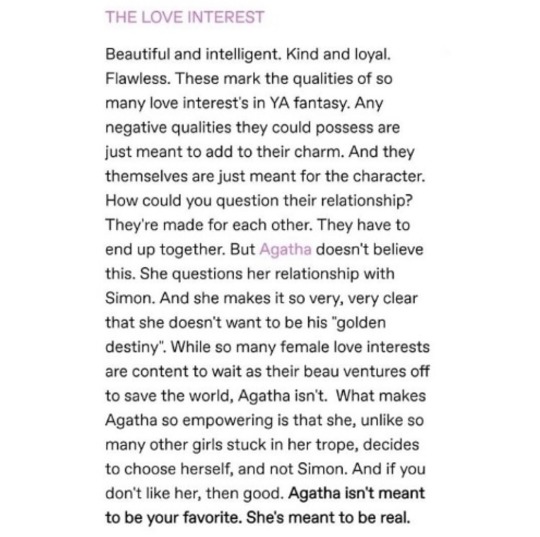
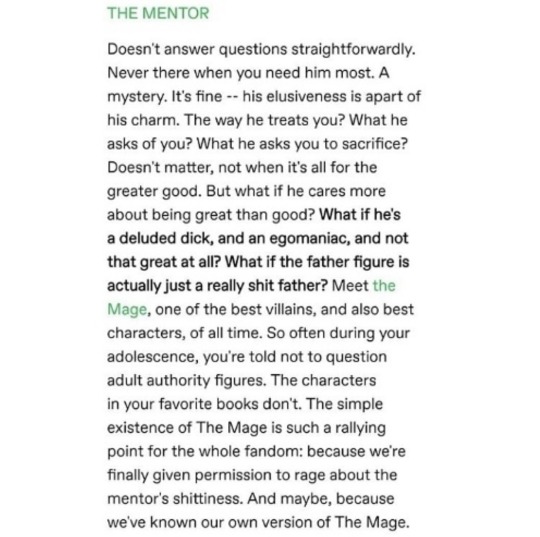

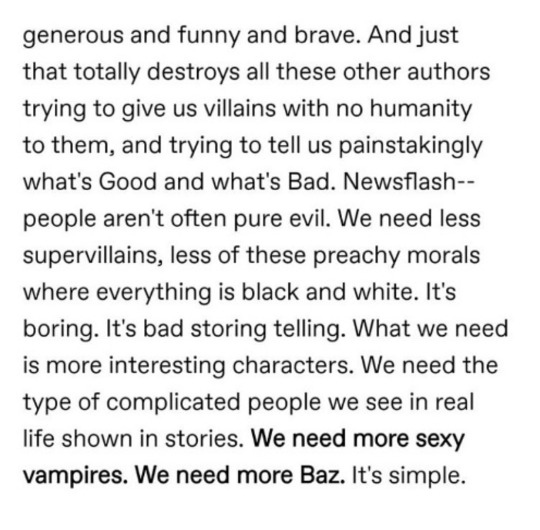
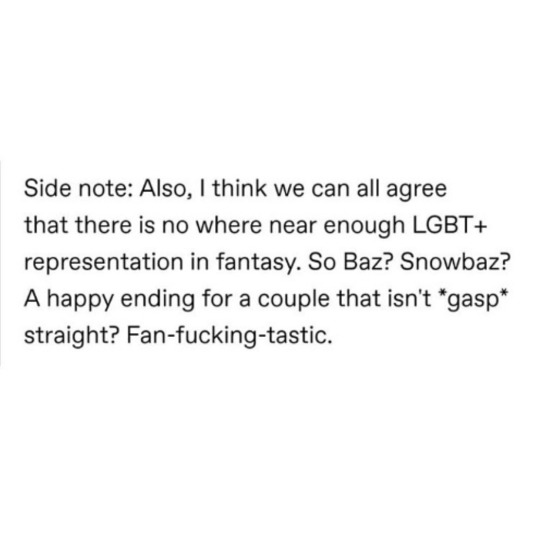


This excellent essay was posted by @goodbyedandelion and reposted on Instagram��however their account sadly seems gone now. But it is in rememberence of their Tumblr spirit that I post a continuation to their essay!
EVEN MORE Reasons Why Carry On is so groundbreaking as a YA Fantasy/Romance
Misconceptions/Character Complexity
A large topic in YA Contemporary is gossip, but I feel like fantasy doesn’t touch on this as much. Think of how others perceive one another in Carry On. Early on we learn that Simon, for example, saw Penny as different because of her race. But of course, we quickly know this isn’t true.
But what about Agatha? In Harry Potter, for example, Lavender Brown and other feminine characters are often looked down upon because of their femininity. We often as a culture perceive beauty as overcompensation for what’s inside. Sometimes Agatha is looked at in the same light in Carry On, but when we see things from her POV, we realize that Agatha is perhaps the smartest one there. Maybe she’s not Penny Bunce-smart, but she has the survival instincts that Penny lacks.
Agatha isn’t the only one. Baz looks cold and unfeeling from others’ POVs, but we quickly learn that he is a boy with a soft heart that’s been hardened by his past. Everyone thinks he cares about nothing but we know he cares about his mother and how she’d feel about him; his father and step-mother and siblings; Simon, of course; Bunce, in his own way; he even cares about flowered suits and dramatic entrances! We think Bunce is nerdy and perhaps annoying, but we learn she’s very sweet and like a mother to Simon. And the mage. Ugh, the mage. We think he cares about Simon but we learn that for every bit he cares about Simon, he cares about the war more.
Rowell doesn’t allow any character to be simple, stereotypical, or as they appear. My sister, for example, was saying that Baz sounded like a stereotypical gay man in the media. But he’s not, is he? He might love fashion but Rowell does not make him simple or stereotypical. Everyone is so complex, and she uses the multi-POV to not just show us their complexity but also the complexity of how they are viewed by others.
Woman on Woman Drama/Anger
For years and years, only one woman was allowed to have a true seat at the table in films. Take Indiana Jones, the original Avengers, and Star Wars for example. This woman was often made to be the sex appeal or romantic interest, but I’ll save that for another day. Because of there only being one spot, it set a precedent that women in media needed to fight with each other to take that spot, thus depriving us of women getting along!
At first, I was worried Rowell had fallen into this trap. Bunce thinks Agatha is simple and too feminine, Agatha thinks Bunce is a major pain in the ass. Their dislike for one another is complicated in that they’re essentially two different types of feminism battling it out, and half of their fight was about Simon and their roles in his life.
But in the end, Penny and Agatha create a relationship that exists outside of their relationship with Simon. Penny sees Agatha’s strength and resilience; Agatha recognizes Penny’s harsh exterior for what is is. When Agatha moves away, they text without his even knowing. Penny is the one that decides they need to check on and save her. In the end, penny and Agatha fight alongside one another.
Rowell didn’t just give us a feminine friendship—she showed us what we’ve been doing, and how to get from Point A to point B. I think it’s the most underrated part of the series.
True Friendship
It might sound bad, but I truly believe a lot of today’s media ruins the idea of friendship. I just feel like none of the portrayals are realistic. Friends are either joined at the hip and have never fought (toxic) or never get along (also toxic). The fact that Baz and Penny and Simon and Penny and Agatha and Penny can get into fights but still continue to love one another platonically is really heartwarming to me.
Trauma/Mental Illness
I remember getting to the end of Harry Potter and thinking “he went through all of that and we’re just supposed to leave him now?” We see some remnants in the most cursed play ever: The Cursed Child. But more than trauma we see someone who looks back on the days they risked their life everyday with *longing.* While that’s about the most Harry Potter thing Harry Potter has ever done (and the most canonical part of that play) it’s so unrealistic. You’re telling me Harry grew up with nothing and was an amazing father—minus a few spats with his son. You’re telling me Harry was able to hold it together emotionally after fighting for his life from ages 11-18 without a therapists help? You’re telling me Harry lost two father figures in the ministry of magic AND spent 7 years going through what amounted to a lesson titled “the government is corrupt” just to be a part of that government!?
Wayward son isn’t like that. Wayward Son shows us what happened to Simon afterwards, and it’s not peaches and cream. He had therapy, he quit therapy. A lot of us have been Simon on that couch, and we all needed the Baz in our life to drag us across a metaphorical America. Wayward Son is hands-down my favorite book. Realistic depictions of mental illness, check. Subverting our expectations of after the end, check. Reading it feels like taking a road trip, check.
As OP mentioned, Simon is a beloved chosen one because he’s just so wrong for the role. He’s not levelheaded where he should be, he’s bold in all the wrong places, he couldn’t possibly maintain a professional relationship with the coven. Meanwhile his super-hot enemy Baz was the absolute perfect choice to be chosen, but he was completely passed over. And part of this chalks up to how Simon became so powerful—fate isn’t twisting its whims this way and that. Simon is only chosen because he was a Petri dish experiment-gone-wrong baby. When Simon asks the fates why, really he should be asking the mage. There’s something delightful about the fact that Simon was made. The chosen one was made, and in the same process, so was the greatest threat.
De-escalation
I think it’s clear by now that Carry On is a great book, Simon Snow is an amazing series, and Rainbow Rowell sure can write. But I feel the need to point out that the end of Carry On wasn’t well-received by everyone. I recommend the series to everyone I know and some people are really disappointed you don’t get a big magical battle at the end. Some people think Simon filling in the humdrum was a cop out. But I disagree. I felt it was thrilling to witness a book where war was as stupid in fantasy land as it can be in real life. This is the first fantasy I’ve ever read where they find a better way to handle conflict than senseless fighting. It’s emotionally rewarding, to me, to see de-escalation. To see conflicts fixed before they start to be huge problems. It was a risky choice for an end, you have to admit. But Rowell pulls it off amazingly.
Nothing is Wrapped in a Bow
A day will never go by without me thinking about the fact that Simon Snow Salisbury doesn’t know who his parents are. Or how Baz will never know what exactly happened with his mother—whether she really ended herself to avoid vampirism and whether she would’ve done it to her too. We’ll never even quite understand the mage’s plan behind fix the humdrum and get an all powerful boy wizard on his side. Rowell doesn’t wrap everything up. She gives you closure as often as she gives you something to ponder. The ending of Harry Potter was so controversial, I think, because it spelled out so clearly much of what was happening. And what you didn’t learn in that epilogue, Rowling released later through Pottermore and interviews. That’s fine and dandy—but there’s something to be said for ending Simon Snow’s books with questions. Not infuriating questions but rather things that I’ll always ponder—that will shed new light on different situations depending on how I look at them. Rowell sets a precedent that you can fill in Simon’s world with your imagination while also reminding us that life doesn’t have endings. Not really, the way books to. Rowell is one of the few writers of today’s fantasy, I’d argue, who’s okay letting things go unanswered. There’s always a thread of fantasy and magic going. It’s something that will keep Simon alive in my heart for many, many years to come.
So yeah, that’s what I think about when I think about Simon Snow. It’s not nearly as coherent as the original post but I hope you enjoy it.
#carry on rainbow rowell#simon snow#simon snow series#baz grimm pitch#carry on#simon snow salisbury#baz#any way the wind blows#baz pitch supremacy#co/ws#simon snow supremacy#penny#penny bunce#shepard from omaha#shepard#agatha wellbelove#fiona pitch#lucy salisbury#awtwb#carry on wayward son#wayward son
616 notes
·
View notes
Text
Bisclavret Round-Up
Unholy took about three months to write. Fairy Tale took five. Hindsight took six.
Bisclavret took nineteen, and that should be the biggest indicator to you that I didn’t know what the hell I was doing.
This was my first venture into another fandom, and out of my comfort zone (though not entirely – supernatural elements for life). I’m not sure whether or not I did the source material and its characters justice, however, especially with the supernatural element I went with (Wolves are believed to have gone extinct in England in the late fifteenth or early sixteenth century), but I will try to explain my reasoning behind some of my decisions here.
The Characters
My main concern.
We get a good view of Monty’s thought process throughout the show, through the framing device of writing his memoirs and views of his private affairs. Phoebe and Sibella, on the other hand, are characters we don’t get much of in the way of examination – we only see them through Monty’s eyes until the very end, where they reveal themselves as more than that.
Sibella is a bit self-centred, and extremely practical when it comes to how she sees her place in society, which implies some self-confidence issues. Phoebe is more idealistic, and independent, but still hopes for a match fit for a storybook. But, towards the end, Sibella demonstrates she is more than a vain god-digger, afraid of losing the man she loves and willing to potentially compromise her image to save him, while Phoebe shows that she is not nearly as innocent or naive as the people around her consider her to be.
I interpreted the two women’s characterisations as thus; Sibella believes she is bound by society’s view of her. Phoebe does not. This, I believed, needed to be the focus.
Which is where we introduce…
The Whole Werewolf Thing
“[Post-modern Gothic] warns us to be suspicious of monster hunters, monster makers, and above all, discourses invested in purity and innocence. The monster always represents the disruption of categories, the destruction of boundaries, and the presence of impurities and so we need monsters and we need to recognize and celebrate our own monstrosities.” - J Halberstam, Skin Shows: Gothic Horror and the Technology of Monsters
I gave a number of possible causes of the D’Ysquith ‘family curse’, if it is one – the actions of the first countess, Gregory D’Ysquith burning down a monastery (divine punishment is a possible cause), but I never gave a specific answer. I think I might be operating on the logic of the original Bisclavret – it’s irrelevant.
The reason there isn’t is because I intended it as a metaphor – which I think I’ve made clear with my chapter updates here (though you don’t have to read it that way, Death of the Author and all that), but I never quite decided and what it was a metaphor for. In terms of this particular narrative, it can be read as a metaphor for feminism, and/or a metaphor for same-sex attraction.
Feminism
Edwardian Era England, where A Gentleman’s Guide takes place, is not overly-represented in fiction. Not surprising, considering it’s a pretty short time period between the surprisingly long Victorian era and the world-changing events of World War One. However, when you think of that time period, a certain group tends to come to mind – the suffragettes.
(Just a note. Agatha D’Ascoyne, the character from Kind Hearts and Coronets who inspired Hyacinth D’Ysquith in the musical, was a suffragette. She has no lines, apart from “Shush!” – Deeds, Not Words.)
We know what these people wanted – Votes for Women. They were not prepared to wait for society to change to get it, and when peaceful protest was ignored, they began to act out. They refused to fit into their role of quiet, demure, loyal wives, and for some groups, this was seen as threatening. Anti-suffragette cartoons of the time often depicted these women as old, ugly and/or selfish for wanting similar rights to men instead of accepting their place as a ‘lesser being’.
The point I am trying to make is, being in defiance of the role you are expected to play – which Sibella is afraid to show – was seen by many to be ugly. Beastly.
Phoebe runs Henry’s country estate for him. Phoebe flaunts societal expectations by proposing to Monty, instead of waiting for him to propose, the ‘proper’ way to do things. While she is feminine, she does not fit the idea of what a woman ‘should be’.
Sibella makes a point to meet her obligations as a wife, though she does surreptitiously carry on an affair. She sacrifices her own happiness to get what she wants in a socially acceptable way. She has no intention of leaving Lionel in the source material, but she convinces herself that a rich, good-looking, polite man – what society thinks of as the ideal male – is what she wants, and realises on her wedding day that it isn’t.
And goes through with it anyway.
When she can no longer fit that mould, when she refuses to go along with Lionel’s plan to leech off the countess, when she undermines and argues with her husband, that’s when things start happening. Indeed, her ‘beastly’ outbursts manifest as standing up for herself. She ends the story as a much happier and self-assured person than she was at the beginning, and attempts to bring justice to other women.
Same-Sex Attraction
This is a bit more straightforward. We’re coming right off the back of the Victorian era here, where Oscar Wilde and others like him got their lives ruined. Same-sex relationships aren’t viewed in a positive light at all at this time – you like the same gender? Off to prison with you, deviant!
As people that were (and often still are) villainised, misunderstood and attacked for the crime of existing, some members of the LGBT community reclaim monsters such as vampires, werewolves and the Babadook as their own as a means of subverting their image in a heteronormative society. Being ‘monstrous’ is not bad. Being different is fine. You may feel malformed and wrong, but you are not. You and your quirks are accepted.
For some, the ones to fear are those who appear in the daylight.
Sibella, for all her talk of being a monster, only fights back when threatened. Morton has a heart attack when put in the position of his victims, subverting the formula he’s used to. Lionel, fearing that Sibella will leave him and damage his image, resorts to violence against Sibella and several other women he sees as substitutes for her. Mary attempts to murder Sibella for getting in the way of a monogamous man-woman relationship. In her eyes, Sibella is an irredeemable villain, but Phoebe can be ‘fixed’.
If you want to look deeper into this link between horror and the LGBT community, here’s a video essay discussing gay, lesbian, bisexual and transgender representation in horror films.
There are only a few non-metaphorical references to werewolves. The wolf head in Eugenia’s dower house is a family member – as previously mentioned, wolves went extinct in England during the reign of Henry VII. St Hubert’s Key is a charm that more often than not looks like a nail, and was supposed to be able to rid the body of disease caused by a dog or wolf bite. There is some science behind this – the metal was heated before being pressed to the wound, and, if the subject was at risk of contracting rabies from the injury, the heat would likely sterilise and cauterise the potential infection site.
Not the First Murder-y Heir
There are a couple of characters named or directly taken from Israel Rank – Autobiography of a Criminal, the inspiration for Kind Hearts and Coronets and A Gentleman’s Guide to Love and Murder. I’ve compared these works before, so I’ll just go over those that appear here.
Esther (Lane) – The third object of Israel Rank’s affections, and a governess. Knows more than she’s letting on in Israel Rank, and in this story as well.
James “Jim” Morton – Appears for about a page to explain Israel’s disillusionment with the ideal male – while Morton seems great to some, he really isn’t. Since Jim only appears as a child in the book, his characterisation here is drastically different.
Lord and Lady Pebworth – Almost directly lifted from the book, with Lady Pebworth being a bad singer and Lord Pebworth an older gentleman who lets his wife get away with a lot. The difference here is that Israel introduces the Hollands to the Pebworths, while the Pebworths are hoping the Hollands introduce them to Lord and Lady Navarro.
Sir Anthony Cross – Quiet, very well-off, slightly older gentleman who is quite taken by Sibella, but it doesn’t go anywhere. Acquaintance of the Pebworths. Pretty much the same guy.
Ethel D’Ysquith (Gascoyne) – An ancestor Israel is quite taken with, not only due to the resemblance between the two. He’s made the 3rd Earl of Highhurst because I didn’t feel like making an imaginary preceding title (Monty is only the 9th Earl, while the 10th Earl Gascoyne is about five generations before Israel – Ethel was the 6th Earl) and the 2nd Earl, Roland, had already been named in the musical. Phoebe’s description of him is meant to heavily imply he was also a werewolf. If I had read the book before fleshing out the D’Ysquith family tree, he would have taken the role that the first countess plays in the narrative’s events (Ethel Gascoyne hid in a tower with an Italian magician for 20 years).
Kate Falconer – The character who would later be known as ‘Boat Girl’ in Kind Hearts and Coronets and Evangeline Barley in A Gentleman’s Guide. Her great crime is to go on holiday with her boyfriend, and gets poisoned for her troubles. She survives here, and I used her to try a formatting technique (while she speaks, none of her dialogue is in quotes: in a way, she is voiceless).
(Sir) Cheveley Drummond, (Lady) Enid Branksome, and Catherine Goodsall – only mentioned briefly. Drummond is described as handsome and ‘interesting’ by Israel, Lady Enid is a young woman from a penniless but aristocratic family, and Catherine Goodsall in an actress whose abusive husband was beaten so badly by a Gascoyne he joined the navy and never came back to land.
In addition, Lionel’s later characterisation comes directly from Kind Hearts and Coronets, since he gets almost none in the musical. His breakdown in Chapter 11 follows his emotional journey when asking for a loan – affability, begging, threatening suicide, insults and physical violence.
Literary References:
Not always relevant, but there is a wide enough variety that I’m collecting them.
Every chapter title, and the tagline of the work, comes from Manners and Social Usages by Mary Elizabeth (Mrs. John) Sherwood. It’s a bit out of date by the time of this story (written in 1884), but Sherwood does have some great phrases in her etiquette handbook.
Ruddigore is mentioned in chapter 2, only because it is a musical theatre production (opera) where ancestors play a role and family expectations are subverted.
There are more things in heaven and earth, Horatio, than are dreamt of in your philosophy. Hamlet. It’s Hamlet.
When in the chronicle of wasted time, I see descriptions of the fairest wights, and beauty making beautiful old rhyme in praise of ladies dead, and lovely knights... Shakespeare’s Sonnets, Number 106.
I desire, and I crave… Fragment from Sappho’s poetry.
The countess closes her book; something by a George Reynolds. George W. M. Reynolds wrote Wagner the Wher-Wolf (with that spelling) in 1857.
I met a lady in the meads, full beautiful, a faery’s child: Her hair was long, her foot was light, and her eyes were wild. La Belle Dame sans Merci (The beautiful lady without mercy) by John Keats.
Sibella also briefly mentions Algernon Blackwood, a supernatural fiction writer who wrote a short story about a werewolf (portrayed quite differently here) that a character in 1909 could have possibly read (the story was first published in 1908).
In addition, the whole story is named after a very early depiction of a sympathetic werewolf, Bisclavret by Marie de France (and the most direct I think I’ve ever been with a title). It depicts, naturally, a werewolf (who is also a knight, because not being human doesn’t disqualify you from doing that – cutting social commentary for the 12th century) who is trapped in his wolf form after being tricked by his wife and her lover. Through chivalric behaviour to the king on a hunt, he works himself back into the royal court and, when his former wife pays a visit, bites off her nose. The king thinks the sudden aggressive behaviour from his pet prompts further investigation, the wife reveals all, and the knight is restored to human form. Also, all of the wife’s children are born without noses from then on. Lionel getting his nose bitten off is a reference to this poem.
Uncategorised Trivia
This work was written with the UK spellings of certain words, because it takes place in England. Previous works all took place in the US, and so used US spelling.
Les Patineurs Valse is French for The Skater’s Waltz. Reference to Asquith Jr. and Evangeline Barley.
All of the racehorse names Sibella finds are either variations, anagrams or synonyms of actual racehorses in the Victorian and Edwardian eras. Sir Hugh is Sir Huon, Gil Owen is Neil Gow, Irish Lass is Irish Lad, Supervision is Oversight and Pinnacle is Meridian.
Lionel was right to be concerned about Phoebe’s flower arrangement. Red begonias represent love, lavender-coloured heathers represent admiration and loneliness (and are a reference to another fandom I write for), tuberoses are symbolic of wild or forbidden passion (and was commonly used as a funeral flower), and verbena is reference to romance and sweet memories. The dead foliage is meant to mean sadness. Overall, the intended meaning is I miss you, my love.
6 notes
·
View notes
Text
ok i’m finally back home w access to my computer so here comes the long-awaited thought dump abt the bbc trainwreck of a show. sorry if i missed certain details or moments, viktor and i were fairly drunk and kind of just shouting at the tv by the end. i'll try to move in a vaguely chronological order through the episodes.
- harker basically taking on the role of renfield but also a vampire was weird??? it was weird. don't like that. and super duper love the fact that mina was too emotionally weak to kill him when he asked for it and her role was literally just reduced to loudly screaming in her two minutes of screentime and then Off Screen Heiress Who Donates Money.
- the zombie vampires were cool. didn't make sense, but they looked cool.
- i don't even know where to start with the awful queerbaiting fetishistic bullshit they pulled with harker and drac.
- this is a minor thing, and maybe it was just me, but the actor playing harker seemed so unsuited to the role? he wasn't a bad actor, he just looked like a 40 year old accountant named nigel, not a law clerk in his early twenties. it was just odd, especially because mina looked about 16.
- i'm just gonna address this here, but it's a blanket statement for all three episodes: everything that comes out of drac's mouth is either so obviously m*ffat using him as a mouthpiece to show how Smart and Clever and Woke and Edgy he is or it's a painfully cheesy """"quotable"""" one-liner. that's it. there was never any in between. with every single bit of dialogue, m*ffat was either wanking off to how clever he was or wanking off to how witty and funny he was. not a single line seemed natural.
- i love a bit of gore and body horror, i really do. when it serves the story, it's great in horror. but so much of it in this show was clearly for the shock factor. drac climbing out of a wolf corpse doesn't make sense when he should just be able to shapeshift. does he crawl out of teeny tiny bat stomachs, too? fuck off. it didn’t make sense. the only place where it was almost done well was with dracula wearing harker’s face.
- WHY DID I HAVE TO LOOK AT TEN SOLID MINUTES OF CLAES BANG'S NUDE ASS AND HAIRY CHEST. WHY, BBC. I DIDN'T WANT THAT. NO ONE WANTED THAT.
- the demeter episode, i almost liked. it had some good tension, especially at the end. it did a decent job of getting you attached to the characters.
- just... everything between lord ruthven and drac. it was so awful. it was the worst homophobic bullshit of the show. yeah, let's have this character get seduced by one touch of dracula's hand on his leg and then go Gay Crazy and shoot someone for his vampire love who then kills him. that's not homophobic at all.
- piotr was adorable, i'm glad he got away with Obvious Imitation Of Long John Silver.
- when the helicopter noise came, i wanted to die.
- zoe shouldn't look exactly like her great great aunt? that's not how genetics work? is she a reincarnation? do they address this and i was just too drunk and angry to notice?
- knew they'd pull the 'lucy is a slut' bullshit. called it. and no, m*ffat, having her """wokely""" name drop the concept of slut shaming in dialogue doesn't excuse the fact that you're literally basing her whole character on exactly that. her only two character traits were Being Slutty and Taking Selfies. i wish i was exaggerating, but i’m not. that’s genuinely all there is to her character.
- i already mentioned that the quincey stuff pisses me off, but his reveal in the scene is also so weird?? it seemed like lucy either just met him at the club or she at least hadn't known him that long, since she was introducing him to everyone, but all of a sudden he was proposing to her. that seemed so jarring. without adding much more dialogue, they could've made a situation that made more sense and preserved more of quincey's character from the book. if you really want a club scene, have quincey be there, but instead of his weird fuckboy remarks to jack, have a short conversation where jack mentions that quincey’s been dating her for a while and always seems uncomfortable at the club, then have quincey say that he's not really a club person but loves her enough to keep coming along if it makes her happy. that's it. that establishes that they've been dating long enough for him to propose and that he's a decent guy who genuinely cares for her. but nope, gotta turn it into some weird thing about how the party girl goes for the rich douchebag instead of the kind nerd.
- jack seward was good. literally the only good character in the show. absolute baby.
- the whole thing of getting memory and skill from blood was really dumb. m*ffat must've thought he was the cleverest man alive by twisting 'the blood is the life' into 'blood is lives.' good job. even more dumb was zoe drinking dracula's blood to somehow commune with agatha? how the fuck does that make sense?
- i can't believe the plot twist from dracula 2000 where dracula is actually judas iscariot from the bible was somehow better than this mess of hot garbage
#( * ooc. )#dracula spoilers //#bbc dracula spoilers //#dracula 2020 spoilers //#there's more shit i could say but#jesus christ
6 notes
·
View notes
Text
THE WICKED + THE DIVINE: 1923 AD AKA A WORK OF ART(IFICE)
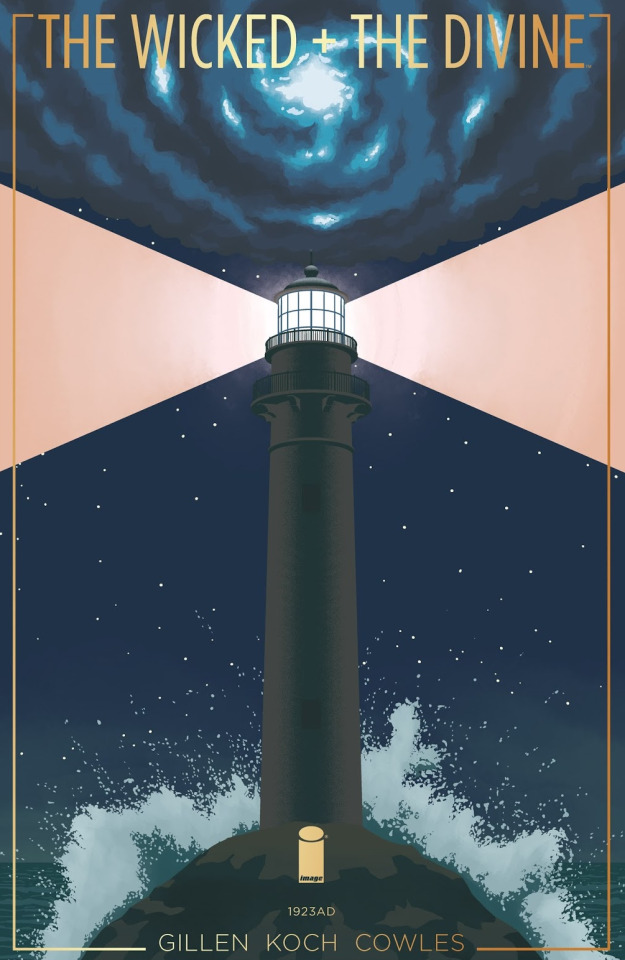
This issue is the Peakiest of Peak Gillen -- Gillen to the Power of Peak to the Power of Peak, if you will, #MathisCool. It’s a comic book masterpiece of research, reference and storytelling and I’ve been so daunted at attempting to comment on that it’s taken me months to make the attempt. You only climb Everest once, people! (Shut your mouth, Nat Geo.)
WAGNER VERSUS WARHOL, FIGHT!
In format the issue involves a back and forth conversation/rap battle between high and low art. On the one hand, we have novelistic chapters rich with description. “The island looked like a threat, a fist of rock that had forced its way through the waves.” The island and Ananke both...
Then we cut to what at first glance seems like your standard comic book, but in fact is actually a riff on the early days of film, complete with title cards (which themselves get so silly the font might as well be comic sans #IllBeHereAllWeek) and everything shot in a wash of black, white and brown, except for the splashes of red at the scenes of death—victims’ blood, Lucifer’s apple, and my favorite, the red seaweed around Neptune.

Love that red seaweed.
The heart of the plot follows a similar back and forth, as the elitist “classic” artists, the TS Eliot/Ezra Pounds and Ginny Woolf-ish-types of the Pantheon, want to kill the more popular art types, the Shirley Temples and Buster Keatons and Robert Johnstons, to initiate a nightmare scenario that will supposedly give them control over the zeitgeist of the future. It’s an incredibly disturbing take on some of the giants of the early 20th century -- and one Gillen found based in fact.
It’s fascinating, too, for as much as the real object of venom is the truly popular artists, the movie star types with their simplistic narratives and opium for the masses, the elitists focus on killing figures who from our perspective sit far closer to them – Lucifer (F. Scott Fitzgerald), Poseidon (Ernest Hemingway), Dionysius (Pablo Picasso) and the Morrigan (James Joyce). I wonder if it’s something about the chaos those specific figures represent, the way that their particular forms of art end up undermining not only the structures but internal belief system of the modern world. If Baal-Et-Al’s idea is to work with Joe Goebbels to coopt pop culture for their own We Will Keep Control project, in a sense a Picasso or Joyce was doing the reverse, presenting in the formats of the elites only to deconstruct their validity. (Gillen’s notes on the Morrigan point in this direction. Also, his description of Set as coming off “a little like Tahani from The Good Place made me laugh out loud.)
In the end our good guys will stop the bad using their own popular media, film from a train, which was in real life the very first motion picture, and terrified people back in the day for exactly the reason that they feared the train was real and was going to leap off the screen and kill them all.

Writing perfection.
HISTORY IN REPETITION AND RHYME
As we’ve seen throughout these specials, we get lots of echoes between periods here. Lucifer is once again the first one killed, the Morrigan is once again a character all about voice and drama (I love his self-narration so much, please sir can I have a spin-off?), the Norns are still trying to figure everything out, Susanoo=Dandy Baphomet, complete with his own complicated dating relationship (those rings made out of light, though, such a pristine beauty of a moment that Baph never gets), and Woden is once again a gross racist hack misogynist -- that submarine has got to be phallic, right? -- who has stolen his tech powers from someone else to produce content that is entirely derivative while secretly playing the gods and being used by Ananke.
There is also another mechanical creature, “Little Brother”, which we see only for a few panels, and that is not nearly enough because it is an adorable looking flying squid. (SCREW YOU BABY SHARK, BABY FLYING SQUID IS EVERYTHING.) Ananke also works from her standard playbook here, the Prometheus Gambit ��� you can gain some life if you kill others, which Baal et al will then use for bat#!% crazy purposes, which of course is also part of her plan.
And Minerva is also once again a child who seems maybe to be working with Ananke. It’s clear right from the start that the whole Shirley Temple schtick, lots of Yays and Gollys, is just an act, part of her “character”. And we get a glimpse of the real her again at the end.
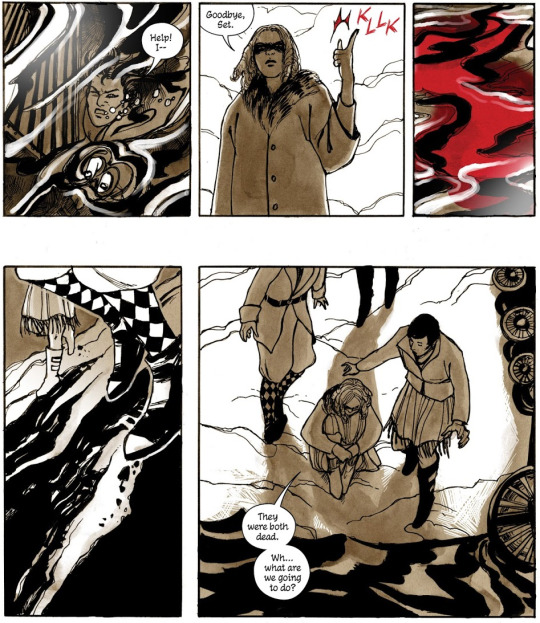
That doesn’t have to mean she’s in league with Ananke. (Just read the next arc; she’s totally in league with Ananke.) But she also comes to know what happened to Verdandi, when she wasn’t with the group that discovered him. (Dude: She’s totally in league with Ananke.) And it gives her an excuse to leave Morrigan at precisely the right moment for him to get murdered by Ananke. (Yes, exactly, because she’s in league with Ananke.) And she will kill Set herself without a second thought; it’s all still just hint and innuendo (UGH NO IT’S NOT STOP), but given what we’ve just learned in the present day that’s all we need for now.
Meanwhile Baal is in some ways the opposite of ours, a racist white elitist who dismisses James Baldwin-type Amon-Re as incapable of being an artist given his “nature”, and Set is her own thing too, a snobby name-dropping Virginia Woolf. Most intriguingly, the Norns have internal divisions that break them down, which make me worry a little bit for Cassandra and her friends.
Best take care of your family, Cassie. Remember, in #WicDiv no one is just a sidekick…
CREATURE(S) IN EBONY This is the second special where the Fall of the Gods involves the introduction of a new being created by the gods by way of a classic Ananke “Definitely Don’t Do This (wink wink)”. In 1831, Lucifer and Morrigan resurrect Hades to create an energy vampire that after killing them merged with Woden Shelley to create Steam Punk Elsa. This time the being – again a woman – is described as “looking like some ancient ancestor of the Metropolitans, but made of living poetry and bleak lightning rather than simple metal.” Which sounds an awful like the 1831 Creature.
She also emerged from “an ebony luminescence with streaks of blue beyond blue”, which again, sounds a lot like Mary Shelley Elsa Frankenstein.
Almost 92 years later we’ve heard nothing from her. But Kieron never forgets anything, INCLUDING YOUR BIRTHDAY, SO WATCH OUT. What could this all possibly mean…
ANANKIERON CHRISTIE
For me the most interesting element of 1923, though, is everything to do with Ananke. We come into the special, like the last two, knowing she is our Big Bad (probably, I don’t know you guys, I think in the next arc Kieron’s going to make me feel bad for her and I don’t want to). (No worries, he didn’t, or did he, wait, there are two Anankes now, I don’t know, what?)
But here for the first time we enter into the story alongside her. In fact, in that very first shot it almost seems like she’s looking right at us.
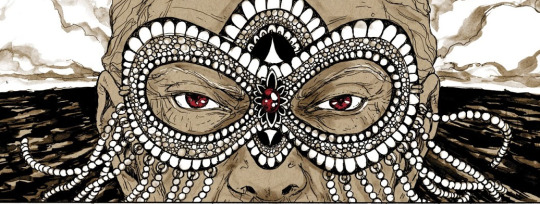
Time’s running out, she’s got to get to the murder-y and behead-yness stat, and this time we get to watch her do it. Awesome!
It’s almost like we’re partners in the exercise, even; right before they’re about to go in for dinner and discover Lucifer Ananke seems to stop and look at us again.
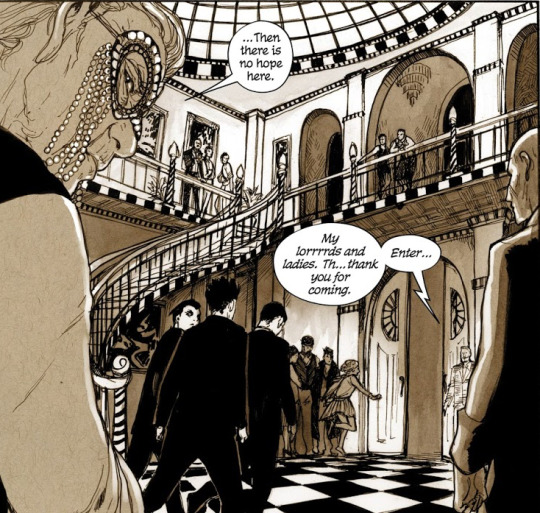
Us and the millennia-old serial killer of children--High fives all around!
For the last 30+ issues I’ve been asking why Ananke is she always wearing a mask, and now finally I get it: just like the Pantheon, she is an actor giving a performance.
Here specifically she presents herself as a classic Agatha Christie protagonist, finding herself along with everyone else in the Remote Place version of a locked room murder mystery and slowly working to uncover the truth of what’s going on while others continue to die. And Then There Was Fun!
Except in fact Ananke is not The Marple but Christie herself, author of the entire series of events that happen, which makes this to my mind pretty much the greatest Christie story ever, and also reinforces the belief of All of Us that Jessica Beatrice Fletcher is the Greatest Fictional Serial Killer that Ever Lived.
But wait, though. Doesn’t that make Ananke basically…a writer? Like um, this guy…?

But that’s crazy. We’ve spent the last five years with him. He’s fine.
I mean yes, both he and Ananke fashion fictional Big Bads (Note: this issue has absolutely no trace nor mention of a Great Darkness, despite the fact that this entire Pantheon has been around almost to their Use By) and also Ways to Save the World which motivate the characters down paths which lead to their eventual destructions.
And okay, true, in this issue Kieron does spotlight/ridicule parts of the storytelling mechanic, the machines characters are always trying to find/build/repair as nonsense.
Such rituals are actually simple. It is about will and art. The machines…in my experience, they are little more than props. All that matters is your action and intent. They killed so the world would die. You die so the world can live.
But still, if we were to accept that Ananke is Just Kieron’s, er, Mask, then it’s like this whole time he’s been the one doing terrible things to all these characters, including the characters that he made me want to love.


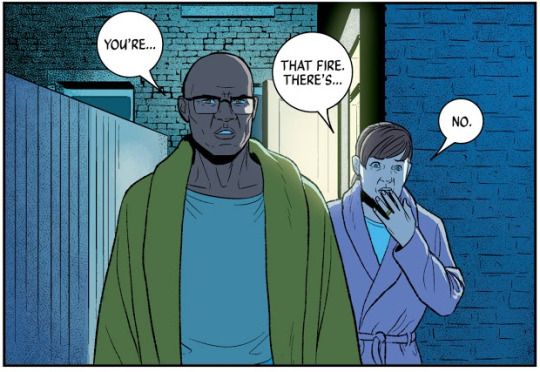
And then this question which I’ve been chewing on since 455 AD, whether the characters can ever be free of the roles they’ve been assigned, in a sense becomes a question about whether they can ever escape not Her but Him…
Or what about us? The Audience. The ones that Jamie and Kieron and the others are creating this for.
This isn’t And Then There Were None, is it? No, this is Temple of Doom. Kieron may be Mola Ram, but I’m the Ever-Hungry, Never-Satisfied G--D-- Kali.
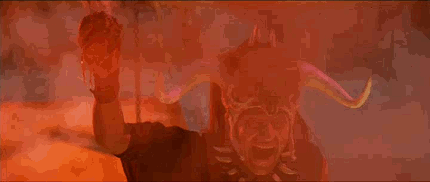
All along, Kieron has thrown in these moments where we get glimpses of the broader world, the way it feeds on the Pantheon. And I can get to the end of 1923 AD and say there’s a fascinating battle going on here about the ethics and/or violence of being a writer. But maybe there are also deeper questions being asked of me as a reader.
Maybe the issue begins with Ananke looking at me like that for a reason.
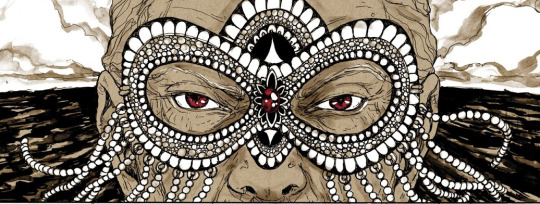
STOP IT, ANANKE. YOU’RE MAKING ME UNCOMFORTABLE. LOOK AWAY.
WORLD WARS, IRL AND URL A last point: 1923 AD is unusual for the degree to which it is haunted by something external, aka war. Even as the story takes place in the effervescent champagne bubble oasis of the Roaring 20s, both the nightmare that was World War I and the possibility of another war which is somehow impossibly much much worse than it hangs over the characters. That’s an insightful take on the period, but also an awe-full twist on the sense of doom that we’ve witnessed in the 21st century Pantheon, their own personal oncoming catastrophes expanded to the scale of disaster for the whole world.
It makes me wonder whether the last act of The Wicked + The Divine will involve something of a similar scale, whether the underlying momentum of the book has not always been toward the culture of celebrity, insofar as it engenders adoration, mob-think and a lack of fundamental care for and curiosity in one another, as sign of our own massive social crisis. (See: Brexit. Trump. The Fights My Dad Gets in on Facebook.)
Are we doomed? Do I still have time to tweet a thread about it? I really think it could make a difference, you guys.
4 notes
·
View notes
Text
New from Robert Daniels on 812 Film Reviews: 812filmreviews’ Top 25 Films of 2019
2019 is coming to an end, and because of such, I’ve put together my Top 25 Films of the Year. It’s the third time I’ve made such a list, and over the course of twelve months I’ve visited nine film festivals and watched nearly 250 movies. So suffice to say, there were more than a few worthy candidates.
Nevertheless, a couple items to take note of before you begin reading: There Nevertheless, a couple items to take note of before you begin reading: There are no entries for documentaries on this list. Inevitably, with these countdowns many fine docs are overlooked in lieu of narrative features and I’d rather not forget those works. I’ll have a separate top ten in the coming days specifically for documentaries. Additionally, only films that have had a wide release were included.
The list you’re about to read is an assemblage of foreign language, Independent cinema, and Blockbusters, and also features a variety of voices: emerging and established, men and women, Black, Asian, Latin, and white. Most of all, they’re the works that have resonated with me the most. That is to say, this is not an objective “Best Of.” These are my favorites. For the films you don’t know or haven’t watched, I hope you take the time to find them because believe me they’re worth the journey. Having said that, below are the honorable mentions and below them—the Top 25. Thank you for 2019, and I hope to see you next year.
–Robert Daniels
Honorable Mentions
A Hidden Life, Clemency, Gloria Bell, Invisible Life, Light from Light, The Lighthouse, Monos, The Nightingale, Queen & Slim, The Report, Slut in a Good Way, This is Not Berlin, Toy Story 4, Uncut Gems, Under the Silver Lake, Us, and Vitalina Varela.
25. Burning Cane (Phillip Youmans)

Debuting at the Tribeca Film Festival, and taking top honors, Phillip Youmans’ Burning Cane not only surveyed the rarely examined Southern Baptist Church, the evocative picture also serves as the first salvo of a new exciting voice. Youmans, an evolving 19-year old filmmaker, presses against issues of toxic masculinity and hypocrisy in an involving and thrilling debut.
Where to watch: Netflix
24. Them That Follow (Britt Poulton and Dan Madison Savage)

A brilliant cast comprised of Kaitlyn Dever, Olivia Colman, Walton Goggins, Lewis Pullman, Jim Gaffigan, and Alice Englert populates another film dissecting the contradictions of zealotry. This time, nestled in a tiny religious community in the Appalachians. Poulton and Savage’s film is a tightening twist of fate, pushing these soon-to-be superstar actors to their breaking points, in an ending that espouses freedom and survival no matter the weight of one’s religious beliefs.
Where to watch: Amazon Prime ($3.99)
23. Midsommar (Ari Aster)

A bear burns, a flower queen rises, and heads are smashed with mallets in a work whose symbolism exemplifies the swing for the fences filmmaking that’s alighted the last two years of cinema. Purely by accident, Ari Aster’s follow-up to Hereditary: Midsommar—is the third film on my end of the year list to examine a secluded religious sect. This one, in Sweden. Blindingly bright cinematography mixes hallucinate effects in a story that examines mental health fueled toward a conclusion that’s quite literally still seared in my head.
Where to watch: Amazon Prime $0.99
22. The Burial of Kojo (Blitz Bazawule)

Lyrical and rule-breaking, Blitz Bazawule’s debut feature The Burial of Kojo is composed through unique camera angles and sumptuous tableaus. A ghost story, the Ghanaian film follows a daughter as she recounts the disappearance of her father and the mysterious reemergence of her uncle in an enthralling picture that examines the colonization of resources by outsiders and income disparity. Poetic and charged, The Burial of Kojo is the nearest thing to a masterpiece by a first-time director.
Where to watch: Netflix
21. Bliss (Joe Begos)

You probably never heard of Bliss until about two seconds ago, but I guarantee you won’t ever forget it. I first watched Joe Begos’ fever dream at Cinepocalypse 2019—where I gasped, leapt, and clutched my imaginary pearls to images of drugs and vampires in an enticing homage to Gaspar Noé. Not only that, but Dora Madison also offers one of the best performances of the year in a fly-off-the-handle explosion of overwrought artistic ambitions that often mirrors Nicolas Cage at his height of insanity.
Where to watch: Amazon Prime $3.99
20. Booksmart (Olivia Wilde)

2018 was the year of actors turned directors, and while 2019 hasn’t seen as many performers switch to the main chair, Olivia Wilde’s debut Booksmart certainly fills one’s appetite. A coming of age buddy comedy that’s as much about friendship as breaking up, Kaitlyn Dever and Beanie Feldstein are more than stars in the making in this milieu of high school drama. Instead, they’ve fully arrived in a film that thrives on Wilde’s teeming ambitions.
Where to watch: Hulu
19. Climax (Gaspar Noé)

With a Gaspar Noé homage already on the list, it’s only fitting that his Climax would also appear. A fever dream that also flourishes through drugs, this one follows a French dance troupe as they devolve into murderous squabbles and other acts of revenge and violence. No film features a more striking use of color, and the opening dance sequence would be the most thrilling music video of 2019 if it were solely designed as such.
Where to watch: Amazon Prime (free with membership)
18. Atlantics (Mati Diop)

A love affair. A ghost story. A critique on capitalism. A tale of feminist freedom in the face of a controlling religious patriarchy. Mati Diop’s Atlantics manages to accomplish all in an array of sensory compositions that attunes the phantasmagorical components of the story to Senegal’s captivating beach fronts and shanty towns. Grounded yet mysterious, the film’s central star-crossed lovers: Ada and Souleiman, represent a passion that reaches beyond watery graves.
Where to watch: Netflix
17. Dolemite is My Name (Craig Brewer)

I can’t adequately describe the glee and reverence associated with seeing Eddie Murphy back in the kind of star-driven vehicle he was made for, but watching Craig Brewer’s Dolemite is My Name at its world premiere won’t soon be topped. Following Rudy “Ray” Moore in his quest to stardom: first through comedy then cinema, Dolemite is My Name gets better on each watch and features one of the year’s deepest and best ensembles: Craig Robinson, Mike Epps, Keegan-Michael Key, Tituss Burgess, Da’Vine Joy Randolph, and Wesley Snipes in a scene-stealing return to form.
Where to watch: Netflix
16. Knives Out (Rian Johnson)

After the abuse suffered at the hands of Star Wars fans angry at The Last Jedi, very few people deserved an out-and-out banger of a film than Rian Johnson. Composed as a Columbo mystery occupying an Agatha Christie frame, Knives Out is a perfectly written whodunit. Featuring another deep ensemble, it’s difficult to pick favorites, but both Daniel Craig (who’s always been a wonderful comedic actor) and Ana De Armas are the highlights in a hilarious film that still maintains political relevance through its skewering of MAGA worshipers.
15. The Irishman (Martin Scorsese)

Admittedly, I’m not much of a fan of Scorsese’s early work. I understand its importance and relevance, but his style never clicked with me. However, his late-period films: Hugo, The Wolf of Wall Street, and Silence—have all resonated: Possibly because they demonstrate a firmer hand and greater control of story than his previous pictures, which I often find stylistically brilliant but lacking in the former. The Irishman, Scorsese’s latest film, exemplifies that patience to the tune of 3.5 hours as we follow Frank Sheeran (Robert De Niro) and his friendships with Jimmy Hoffa (Al Pacino) and Russell Bufalino (Joe Pesci) in a historical drama that’s surprisingly funny yet an elegiac whisper carrying loneliness and regret.
Where to watch: Netflix
14. Little Women (Greta Gerwig)

After Greta Gerwig’s incredible success with Lady Bird, I was more than disappointed that she’d be turning to a remake for her follow-up—especially considering said story already had two stirring versions. Nevertheless, her adaption of Louisa May Alcott’s Little Women is an unabashed success. Perfectly cast—Saoirse Ronan is the best Jo since Katherine Hephburn—the film’s nonlinear retelling sets it apart from prior iterations, while the costumes and score make every scene drip with heart and pure emotion.
13. Parasite (Bong Joon-ho)

Parasite is one of those rare films where someone could spoil the entire plot to you, and it wouldn’t make a difference. Following an entrepreneurial family, so to speak, the picture (along with Knives Out) is another film that critiques the ambivalence of the rich in a twisting tale that constantly takes 180 degree turns. Such is the magic of Bong Joon-ho, a filmmaker whose prior works—Okja, Snowpiercer, and Memories of Murder—have been critically lauded, but who is now finding the mainstream success he richly deserves.
12. Portrait of a Lady on Fire (Céline Sciamma)

Shout out to Valerie Complex, who’s probably done more to promote Céline Sciamma’s Portrait of a Lady on Fire than its own country. Shockingly not Shout out to Valerie Complex, who’s probably done more to promote Céline Sciamma’s Portrait of a Lady on Fire than its own country. Shockingly not selected as France’s submission for the Academy Awards, Sciamma’s lesbian love story between painter and subject features the most stunning cinematography next to Gaspar Noé’s Climax (an odd comparison, I know) of the year, and a breathtaking use of color. They’re the clear residue of the passion that encapsulates every scene. Gorgeous and alluring, Portrait of a Lady on Fire is the literal overflow of spontaneous emotion.
11. Her Smell (Alex Ross Perry)

I nearly walked out of Her Smell. Following the lead singer (Elisabeth Moss) of an all-girl punk rock group, Alex Ross Perry film is split into three part: the descent, rock bottom, and recovery. The first act is one of the most uneasy watches in 2019, as we watch troubled individual who seems fated I nearly walked out of Her Smell. Following the lead singer (Elisabeth Moss) of an all-girl punk rock group, Alex Ross Perry film is split into three parts: the descent, rock bottom, and recovery. The first act is one of the most uneasy watches of 2019, as we see a troubled individual who seems fated for an early demise. However, his movie soon unfurls itself into madness and then ambivalence before finally concluding with a heartfelt final act that’s so earned it physically hurts, as Moss gives the best performance of her career.
Where to watch: Amazon Prime $1.99
10. The Last Black Man in San Francisco (Joe Talbot)

From a compositionally immaculate opening sequence: replete with beautiful sun-drenched lighting, poetic match cuts, and an exhilarating tracking shot—Joe Talbot’s The Last Black Man in San Francisco offers an endearing friendship between Jimmie Fails and Mont (Jonathan Majors) wrapped in a critique of gentrification and extralegal housing practices. Majors truly gives the best male supporting performance of the year, thoughtfully portraying a man who’s an outsider in his own neighborhood and a nonconformist to the cliche standards of masculinity. The Last BlackMan in San Francisco is never hurried, crafting typically static characters with depth and empathy.
Where to watch: Amazon Prime (free with membership)
9. Once Upon a Time… In Hollywood (Quentin Tarantino)

Part of the old white guy nostalgia fest of 2019, Quentin Tarantino’s Once Upon a Time… In Hollywood offers another entry into his alt-history trilogy: Inglorious Basterds and Django Unchained. While many have chagrin in the face of Sharon Tate’s storyline remaining in the background—which I actually think might be the best portion of Tarantino’s flick due to Margot Robbie’s incredible performance—the bromance between Cliff Booth (Brad Pitt) and Rick Dalton (Leonard DiCaprio) takes center stage. A requiem for a bygone era in Tinseltown, everything from the costumes, production design (especially the vintage cars) and parodies, record a moment that never, yet once existed. Finally, the haunting final shot gives Once Upon a Time… In Hollywood a foreboding yet hopeful detour, claiming the title of Tarantino’s most mature film.
Where to watch: Amazon Prime ($3.99)
8. Honey Boy (Alma Har’el)

Art often acts as a balm, therapy for the troubled soul. Few actors have led as turbulent of a career and life than Shia LaBeouf: from child actor to public performance artist. With Alma Har’el’s Honey Boy he adds screenwriter to his resume too. Here, he plays his real-life father—an emotionally abusive rodeo clown, while Noah Jupe portrays LaBeouf in his earlier years, and Lucas Hedges depicts him during his 20’s. Certain scenes—like LaBeouf chastising Jupe—cuts through repressed layers of trauma while delivering an unnerving truthfulness. Every actor fully commits in this on-screen psychoanalysis that often veers between greatness, and a thankfulness that it exists.
Where to watch: Amazon Prime (free with membership)
7. Luce (Julius Onah)

If you’ve followed me since Sundance, you know that I’ve been the unofficial spokesman of Julius Onah’s gripping and turbulent drama Luce. Adapted from J.C. Lee’s eponymous play, provocative and melodramatic set pieces tussle with issues of toxic masculinity, rape culture, and Black Excellence. Onah’s film witnesses a breakout performance from its lead Kelvin Harrison Jr. in a portrayal as much about repression as raw emotion. Moreover, Octavia Spencer provides the rare instance of her in a slightly villainous role, which pulls the best acting of her career. A ball of disquieted energy detonates with each thump of Geoff Barrow and Ben Salisbury’s score, in the turning of a screw that unwinds into catharsis. Unfairly overlooked, Onah’s Luce is what inclusive filmmaking has been building to.
Where to watch: Amazon Prime ($5.99)
6. A Beautiful Day in the Neighborhood (Marielle Heller)

After the success of the Mister Rogers’ documentary Won’t You Be My Neighbor?, the needs for a feature film appeared superfluous at best. But the dream combo of Tom Hanks as the famed television personality and the CanYou Ever Forgive Me? filmmaker Marielle Heller, makes for a deeply affecting story of forgiveness. Ingenious creative decisions: specifically the homages to the children’s program, abound while Hanks offers an incredible show of inhabiting the spirit of a character rather than relying on mere artifice. Matthew Rhys as the picture’s surprising lead Lloyd Vogel—a painfully cynical reporter assigned to cover Mister Rogers, also astounds while Chris Cooper (Little Women) remains one of the unsung heroes of 2019.
5. The Farewell (Lulu Wang)

No movie made me cry more than Lulu Wang’s biographical film The Farewell. Following Billi (Awkwafina)—the fictional incarnation of the director—audiences witness a family who make a nearly impossible decision: to withhold a life-ending cancer diagnosis from their mother/grandmother Nai Nai (Zhao Shuzhen, who’s utterly brilliant). Dissecting several cultural off-ramps: Chinese, Chinese-American, and Japanese—through the guise of assimilation, The Farewell is as much about family as a crucible of truth and identity. The final tracking shot, as Nai Nai waves goodbye is the most devastating soul crushing image of 2019.
Where to watch: Amazon Prime ($5.99)
4. High Life (Claire Denis)

“Bat-shit crazy,” doesn’t accurately describe Claire Denis’ High Life, a mash-up of art house aesthetics and blockbuster sensibilities. Depicting a literal prison in space, the film centers around a group of death row inmates who have volunteered to serve the rest of their sentence in the name of medical research. This batch of offenders, devolve into murder and masturbation in a provacative swing for the fences. And between fuck boxes and studies of isolation and environmentalism, resides Robert Pattinson’s destructive performance. Already the apple of every indie director’s eye—between Good Time, Damsel, The Lighthouse, etc.—Pattinson delivers a cold yet vulnerable performance as both a violent prisoner yet loving father. Making High Life a mind fuck of a Sci-Fi movie.
Where to watch: Amazon Prime (free with membership)
3. Marriage Story (Noah Baumbach)

Some unions end amicably, and some descend into hurtful words that can’t ever be unsaid. Semi-autobiographical, Noah Baumbach’s Marriage Story is a return to familiar territory for the director best known for family dramas. Simply predicated upon a divorce, Charlie (Adam Driver) and Nicole (Scarlett Johansson) are a writer and director from two different coasts (east and west) with a son caught in the middle of their separation.
Initially, congenial their spats occur with greater frequency and intensity. From top to bottom, no film contains a better assortment of performances. Ray Liotta and Alan Alda both offer attention-grabbing scenes in their few minutes on screen, while Laura Dern as a combative lawyer assumes the camera’s gaze. But most of all, Driver and Johansson offer “wow” moment aFrom top to bottom, no film contains a better assortment of performances. Ray Liotta and Alan Alda both offer attention-grabbing scenes in their few minutes of work, while Laura Dern as a combative lawyer unrelentingly commands the camera’s gaze. But most of all, Driver and Johansson offer “wow” moment after “wow” moment, especially in one scene that’s taken a life of its own: the argument scene. Both enter a new stratosphere, in a movie that asks us to do what these characters struggle to do themselves: to see them as equals.
Where to watch: Netflix
2. Ad Astra (James Gray)

“Sad white guys in space” doesn’t faithfully articulate the brilliance of James Gray’s Ad Astra. VFX and production design offers breathtaking vistas mapped across isolation and religiosity. And while many has claimed Brad “Sad white guys in space” doesn’t faithfully articulate the brilliance of James Gray’s Ad Astra. An immaculate use of VFX and production design offers breathtaking vistas mapped across isolation and religiosity. And while many have claimed Brad Pitt’s turn as Cliff Booth in Once Upon a Time… In Hollywood as a career-best performance, such title really belongs to his acting in Gray’s esoteric work. Here, Pitt portrays the unflappable Roy McBride, the world’s top astronaut. However, when unexplained events lead to deadly results on earth, he’s contracted to discover their origins, which might trace back to his long-missing father Clifford McBride (Tommy Lee Jones).
To these ends, the astronaut travels to the far reaches of the solar system in a narrative that calls for the examination of God and toxic masculinity. This deconstruction of the God Complex causes the younger McBride to existentially come undone, which opens his once repressed emotions. A spectacle that wasn’t remotely appreciated in its initial theatrical run (a true shame because this needs to be seen on the biggest screen possible), the film truly deserves the often overused title of “masterpiece.”
Where to watch: Google Play ($5.99)
1. Pain and Glory (Pedro Almodóvar)

Pedro Almodóvar hasn’t ceased making great movies. 2016’s Julieta, for instance, was another commanding work from the legendary Spanish Pedro Almodóvar hasn’t ceased making great movies. 2016’s Julieta, for instance, was another commanding work from the legendary Spanish director. Nevertheless, Pain and Glory still feels like a return to form. Reuniting him with his former muse Antonio Banderas, the autobiographical narrative follows the writer-director Salvador living in regret and agony. Suffering from multiple ailments, he can no longer work and therefore suffers from depression (an ode to Federico Fellini’s 8 1/2). To these ends, he often lives in his memories, typed in private files and hidden away on his computer.
Over the course of nearly two hours, Almodóvar mixes flashbacks with Over the course of nearly two hours, Almodóvar mixes flashbacks with present-day introspection and experimentation by Salvador. The character tries heroine, attempts to mend a broken friendship with Alberto (Asier Etxeandia), and even spends one more night with a former lover. But most of all, he thinks upon his mother: played both by Penélope Cruz and Julieta Serrano, culminating in a final shot, that’s still the most shocking and thoughtfully conceived of the year. Pain and Glory witnesses Banderas in his most vulnerable state, and survives as an undeniable example of cinematic greatness.
Once again, thank you for spending 2019 with me. Please be on the lookout for my Top 10 Documentaries of the Year list, and my upcoming coverage from Sundance. See you in 2020.
from 812filmReviews https://ift.tt/2Q8xzRZ via IFTTT
from WordPress https://ift.tt/2QtGMTM via IFTTT
0 notes